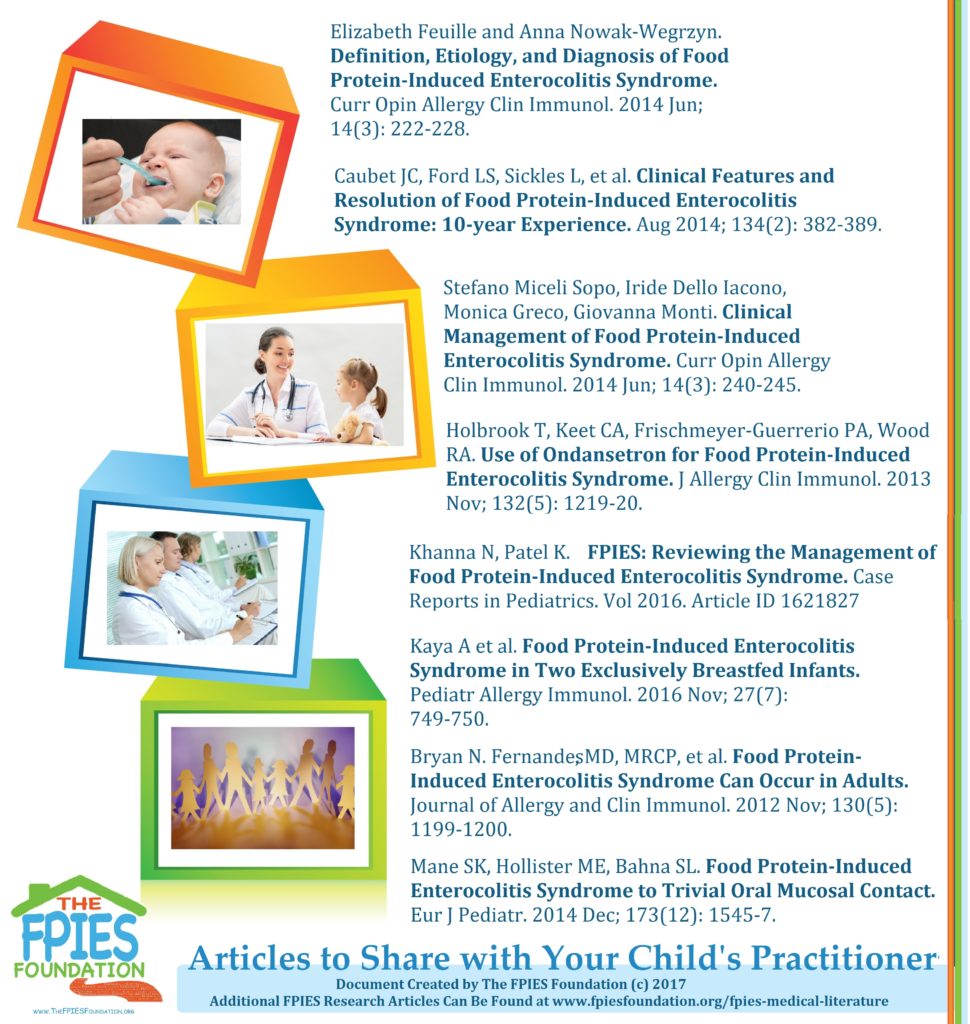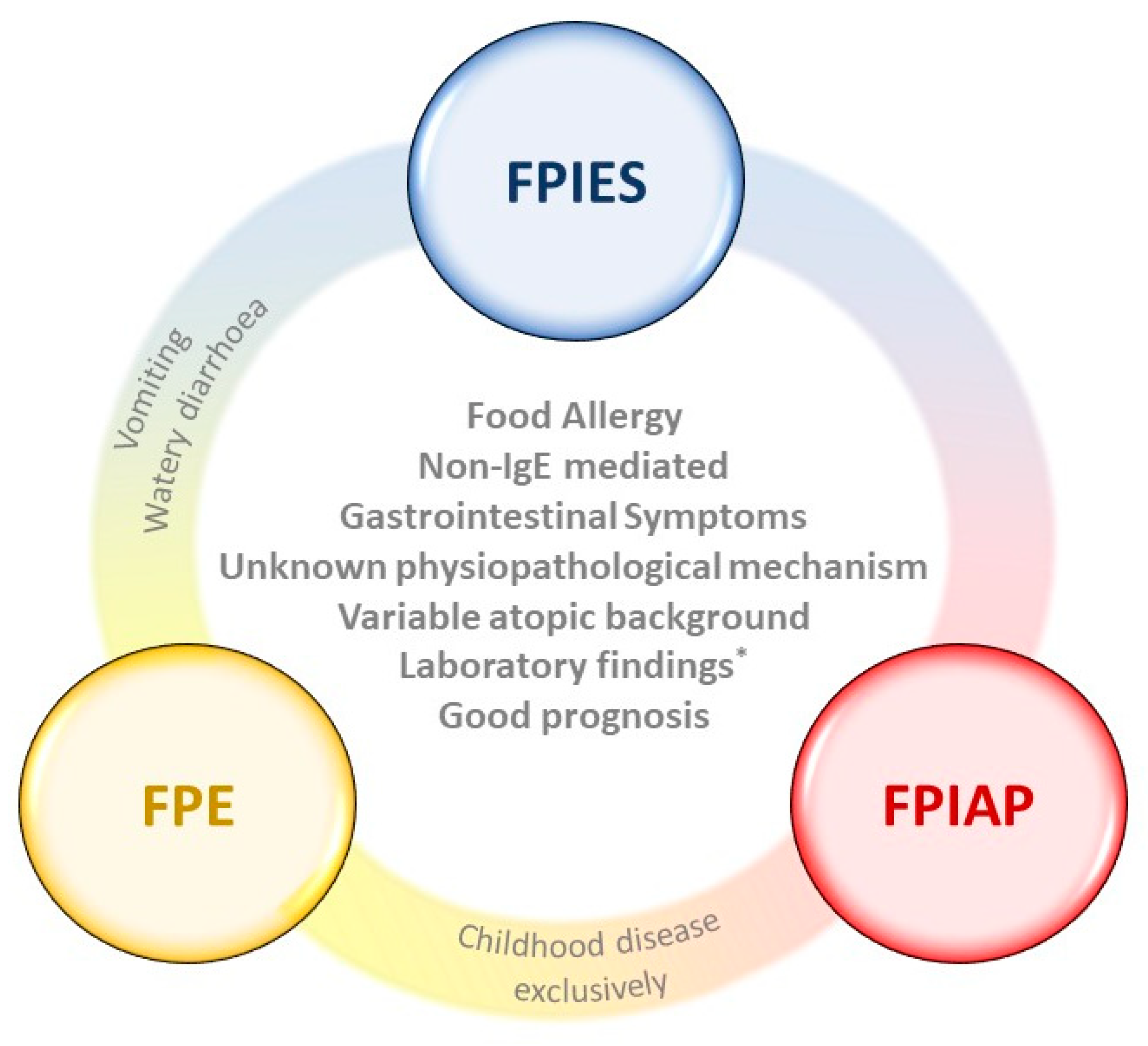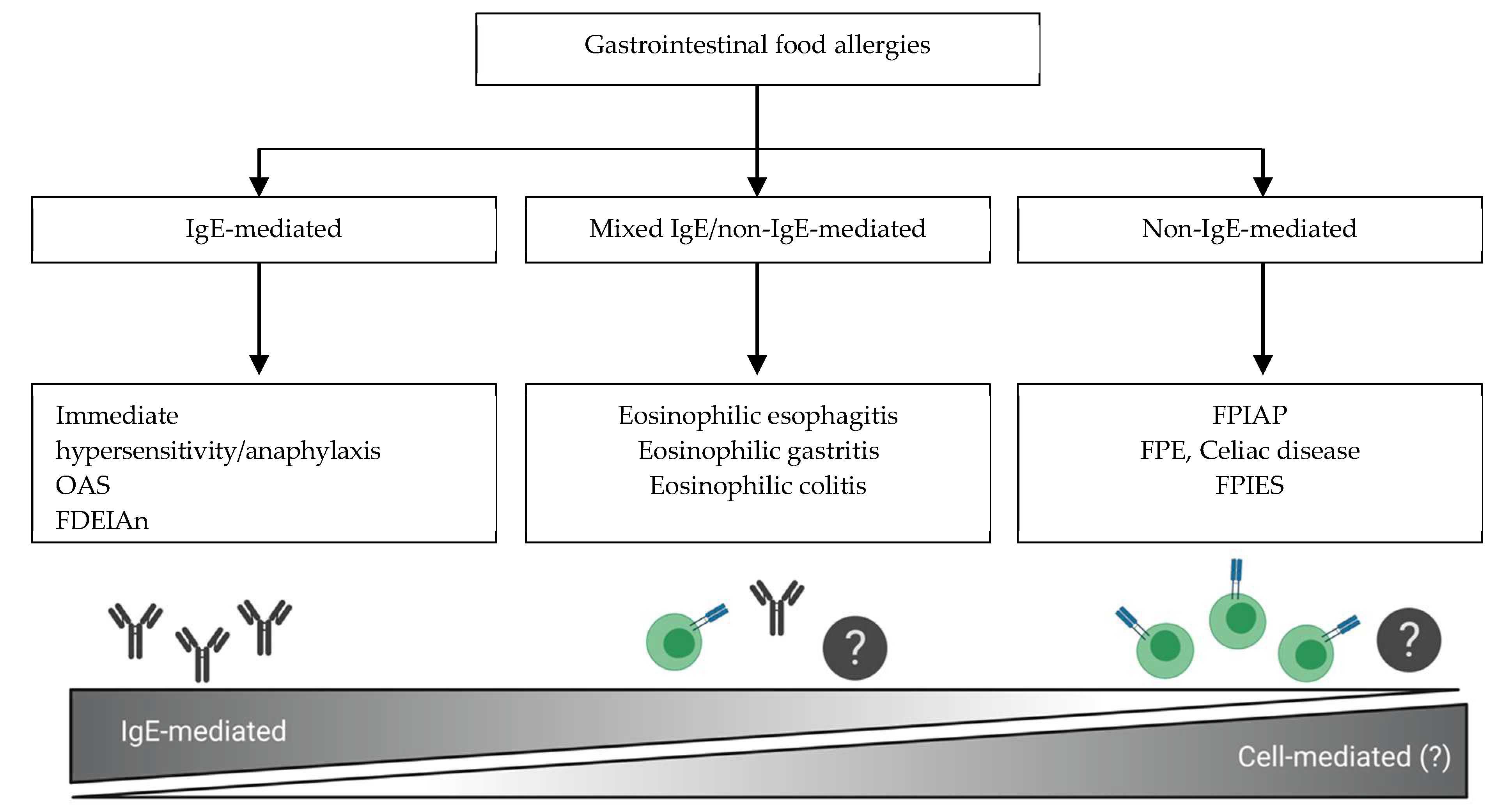food protein-induced enterocolitis syndrome a review of the new guidelines
3 Diagnosis of FPIES is difficult. Cells of the innate immune system appear to be activated during an FPIES reaction.

Toolbox Helpful Articles To Give To Doctors The Fpies Foundation
It is also a cell-mediated reaction to cows milk and soy protein that causes inflammation in the small intestine Food Protein-induced Enterocolitis Syndrome with distortion of villous architecture similar if not indistinguishable from celiac disease but typically FPIES is an allergic syndrome that occurs in the infant displaying a patchy.

. Food protein-induced enterocolitis syndrome FPIES is a non IgE-mediated gastrointestinal food allergy that presents with delayed vomiting after ingestion primarily in infants. And clinical outcomes are poorly established. Unlike most food allergies symptoms of FPIES do not begin immediately after eating.
The workgroup outlined clinical phenotypes proposed diagnostic criteria and made recommendations on management. Food protein-induced enterocolitis syndrome FPIES is a non-IgE-mediated gastrointestinal food allergic disorder that has gained a major interest the past decade. Up to 10 cash back Food protein-induced enterocolitis syndrome FPIES is an increasingly recognized non-immunoglobulin E IgE-mediated reaction to food.
It is most commonly caused by cows milk or soy protein although other foods can be triggers 29012019FPIESProfDrSaadSAlAni 3 Nowak-Węgrzyn A Chehade M Groetch ME et al. High-quality studies providing insight into the pathophysiology diagnosis and management are lacking. Food protein-induced enterocolitis syndrome FPIES is an adverse food reaction involving the immune system that mainly affects infants and young children.
5 rows Food protein-induced enterocolitis syndrome FPIES is a non-IgE mediated food allergy. Food protein-induced enterocolitis syndrome FPIES is a severe presentation of non-IgE-mediated food allergy affecting the gastrointestinal GI tract mainly in infants and young children. The first International Consensus Guidelines for the Diagnosis and Management of Food Protein-induced Enterocolitis Syndrome were published in 2017 and reviewed epidemiology clinical presentation and prognosis of acute and chronic FPIES.
Acute FPIES typically presents between one and 4 hours after ingestion of the trigger food with the principal. Despite the potential seriousness of reactions awareness of FPIES is low. The workgroup outlined clinical phenotypes proposed diagnostic criteria and made recommendations on.
Symptoms may include intractable vomiting diarrhea lethargy pallor abdominal distention hypotension andor shock. The first International Consensus Guidelines for the Diagnosis and Management of Food Proteininduced Enterocolitis Syndrome were published in 2017 and reviewed epidemiology clinical presentation and prognosis of acute and chronic FPIES. While the pathophysiology of FPIES is poorly understood the clinical presentation of acute FPEIS reactions has been well characterized.
1 The timing of food introduction affected the age at onset of FPIES. Food proteininduced enterocolitis syndrome FPIES is a poorly understood nonIgE gastrointestinalmediated food allergy that predominantly affects infants and young children. Reactions are characterized by the delayed onset of gastrointestinal symptoms predominantly repetitive vomiting which is often severe and should be considered a medical emergency.
Individuals with FPIES experience profuse vomiting and diarrhea that usually develops. Food protein-induced enterocolitis syndrome FPIES is a non-IgE mediated food allergy presenting in infants younger than 12 months. Through collaborative efforts of researchers and patient organizations today much more is known about EoE and standards for diagnosis and management have changed.
International consensus guidelines for the diagnosis and management of food protein-induced enterocolitis syndrome. Cells of the innate immune system appear to be activated during an FPIES reaction. Usually the median age at.
Food protein-induced enterocolitis syndrome in the long term Ten years ago eosinophilic esophagitis EoE was considered to be a disease of early childhood outgrown by age 3. The first International Consensus Guidelines for the Diagnosis and Management of Food Proteininduced Enterocolitis Syndrome were published in 2017 and reviewed epidemiology clinical presentation and prognosis of acute and chronic FPIES. Food protein-induced enterocolitis syndrome FPIES is a rare food allergy that affects the gastrointestinal GI tract.
Acute FPIES typically presents between one and 4 hours after in -. Acute food protein-induced enterocolitis syndrome FPIES is a non-IgE-mediated allergy and is characterized by repetitive profuse vomiting episodes often in association with pallor lethargy and diarrhea presenting within 1-4 h from the ingestion of a. Food protein-induced enterocolitis syndrome FPIES is an uncommon disorder characterized by an allergic reaction to food that affects the gastrointestinal system.
Food proteininduced enterocolitis syndrome FPIES is a nonIgE-mediated food hypersensitivity featured by gastrointestinal symptoms such as profuse vomiting and sometimes also accompanied by diarrhea and a systemic inflammatory response. It is caused by an allergic reaction to one or more ingested foods which results in inflammation of the small and large intestine. The workgroup outlined clinical phenotypes proposed diagnostic criteria and made recommendations on.
The first International Consensus Guidelines for the Diagnosis and Management of Food Proteininduced Enterocolitis Syndrome were published in 2017 and reviewed epidemiology clinical presentation and prognosis of acute and chronic FPIES. Food Protein-Induced Enterocolitis Syndrome FPIES is a non-IgE mediated food allergy most commonly presenting in infants. Food protein-induced enterocolitis syndrome FPIES is an allergic disease probably non-IgE-mediated with expression predominantly in the GI tract.
The workgroup outlined clinical phenotypes proposed diagnostic criteria and made recommendations on management. FPIES prevalence which still needs to be accurately determine in different populations appears to be higher than previously thought ie up to 07 in infants in the 1st year of life. Instead it can take hours before severe symptoms begin.
FPIES This disease primarily affects infants. The most characteristic symptom is. 12 This syndrome is typically characterized by profuse vomiting and lethargy occurring classically 14 hours after ingestion of the offending food.
The term enterocolitis specially refers to inflammation of the small and large intestines. Symptoms of profuse vomiting and sometimes diarrhoea most commonly occur two to four. Food protein-induced enterocolitis syndrome FPIES is a poorly understood non-IgE gastrointestinal-mediated food allergy that predominantly affects infants and young children.
The most common food triggers include soy cows milk and grains. Food proteininduced enterocolitis FPIES is a non-IgE cell-mediated food allergy that can be severe and lead to shock. The first International Consensus Guidelines for the Diagnosis and Management of Food Protein-induced Enterocolitis Syndrome were published in 2017 and reviewed epidemiology clinical presentation and prognosis of acute and chronic FPIES.

References In Immunopathophysiology Of Food Protein Induced Enterocolitis Syndrome Journal Of Allergy And Clinical Immunology

Nutrients Free Full Text Non Ige Mediated Gastrointestinal Food Allergies In Children An Update Html

Food Protein Induced Enterocolitis Syndrome Oral Food Challenge Annals Of Allergy Asthma Immunology

Management Of Acute Food Protein Induced Enterocolitis Syndrome Emergencies At Home And In A Medical Facility Annals Of Allergy Asthma Immunology

Clinical Types Of Food Protein Induced Enterocolitis Syndrome Fpies Download Scientific Diagram

References In Food Protein Induced Enterocolitis Syndrome Not So Rare After All Journal Of Allergy And Clinical Immunology

Advances In Understanding Immune Mechanisms Of Food Protein Induced Enterocolitis Syndrome Annals Of Allergy Asthma Immunology

Foods Free Full Text Non Ige Mediated Gastrointestinal Food Protein Induced Allergic Disorders Clinical Perspectives And Analytical Approaches Html

Food Protein Induced Enterocolitis Syndrome The Journal Of Allergy And Clinical Immunology In Practice

Pdf Food Protein Induced Enterocolitis Syndrome A Review Of The New Guidelines

Oral Food Challenge In Food Protein Induced Enterocolitis Syndrome Download Table

Clinical Presentation And Management Of Food Protein Induced Enterocolitis Syndrome In 113 Swedish Children Ullberg 2021 Allergy Wiley Online Library

Clinical Types Of Food Protein Induced Enterocolitis Syndrome Fpies Download Scientific Diagram

Food Protein Induced Enterocolitis Syndrome Annals Of Allergy Asthma Immunology

International Consensus Guidelines For The Diagnosis And Management Of Food Protein Induced Enterocolitis Syndrome Executive Summary Workgroup Report Of The Adverse Reactions To Foods Committee American Academy Of Allergy Asthma Immunology Journal

Pdf Food Protein Induced Enterocolitis Syndrome Semantic Scholar

Interpretation Of The Food Protein Induced Enterocolitis Syndrome Oral Download Table